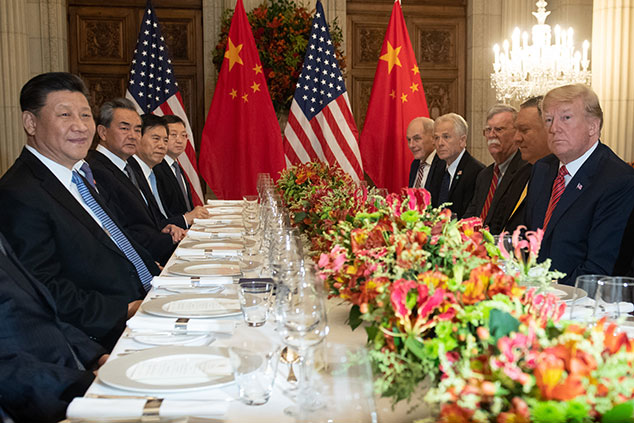
This article is taken from our FREE daily investment email Money Morning.
Every day, MoneyWeek’s executive editor John Stepek and guest contributors explain how current economic and political developments are affecting the markets and your wealth, and give you pointers on how you can profit.
In this week’s issue of MoneyWeek magazine
●
Are there still opportunities in global property?
●
Impact investing: doing well by doing good
●
HMRC: making tax taxing for small businesses
●
Rising interest rates – a cure for the financially unfit
●
An investment trust worth waiting for
● Share tips of the week
Not a subscriber? Sign up here
So were the US-China trade talks at this weekend’s G20 meeting a success?
Don’t worry about trawling the papers.
You need only look at the US dollar this morning to find the answer. It’s fallen sharply.
That means that, whatever the long-term outlook, right now, markets like the outcome.
The US and China strike a truce
The big news that came out of Donald Trump and Xi Jinping’s steak dinner in Argentina is that the US president won’t impose higher tariffs on Chinese imports for 90 days.
That means the current tariff of 10% on around $200bn of Chinese goods will stay where it is, rather than going up to 25% in January.
In return, China will buy “an unspecified amount”, says the FT, of agricultural, energy and industrial goods from the US. It’ll also pay more attention to the problems of intellectual property theft.
Trump also tweeted on Sunday that China plans to cut tariffs on US car imports. In July, Beijing jacked the tariffs up to 40% in a tit-for-tat move, although it also cut tariffs on car imports from other nations from 25% to 15%.
The world’s stockmarkets cheered up as the prospect of a worsening trade war diminished slightly. The US dollar – which has been scaring everyone with its strength – weakened, as investors abandoned their recent “risk-off” stance in favour of a more exuberant mood.
In turn, that meant the Chinese renminbi strengthened, moving away from the ¥7/$1 level that everyone has mentally marked down as a line in the sand, from which an epic devaluation would only be a matter of time.
One of the biggest beneficiaries was the soybeans market – soybeans futures shot up, as these commodities have been among the hardest hit by the trade dispute.
Another side effect is that this will mean there’s less pressure on China to embark on a massive stimulus campaign to offset the current economic slowdown. China is trying to sort out the country’s nasty debt situation, but it’s hard to do that and to keep growth ticking along simultaneously.
If a chunk of your economy has come to rely on an ever-growing pile of debt to sustain it (if it’s a Ponzi scheme, in other words) then as soon as you shut off that credit tap, it’s going to collapse. Managing that process without a full-on financial crisis is not easy to do.
So Xi will be pleased to have the added headache of tariffs off his plate for the time being. And if this encourages China to get back on the path to “reform”, then so much the better. We’ll see.
What this deal means for your money
From an investment point of view, this is what everyone wanted to see. It’s the perfect excuse to add to all the others (including a more relaxed Federal Reserve and an uneventful set of US mid-term elections) for the markets to recover their equilibrium after a tough couple of months.
In other words, it’s another good reason to expect a Santa Claus rally. If tariffs are lower than expected, then growth should be better than expected. That’s one reason bond prices fell (in other words, yields rose) in the wake of the deal. And copper – the metal that most loves economic growth – bounced.
Meanwhile, the oil price rebounded, partly as a result of the weaker dollar, but also because Russia and Saudi Arabia plan to continue to co-operate on the production side. Again, that will help investors who’d been worried that the falling oil price was a sign of something worse than mere oversupply.
The main driver of the last two months of jitters has been fear that we’re heading for a slowdown. If that fear has been taken off the table (however temporarily), then there’s every chance that markets will rush back to “buy the dip” mode, however temporarily.
What about the longer run though? The tricky thing is that for this initial truce to last, the two sides have to make progress during the ceasefire period. That will be all about China making serious efforts to address the issue of respect for intellectual property rights.
Given that China’s economic model does depend on it moving “up the value chain” – ie, producing and exporting more complicated goods – that might be a tougher topic to negotiate on.
So this really is a temporary reprieve, is what most of the analysts seem to be saying.
Could we have expected anything else? China and America’s differences were never going to be sorted out in an evening. What we have to hope for is that they continue to talk, and that we stay off the track that leads to war, rather than one tetchy summit after another.
From an overall investment point of view, it’s something to be aware of in terms of specific threats or opportunities for individual companies. But as far as your core portfolio strategy goes, it’s not something to worry about.
Focus on valuations rather than political ups and downs. We may not know whether the future holds more co-operation or more conflict. But we do know that cheap assets can put up with a lot more turmoil than expensive ones.